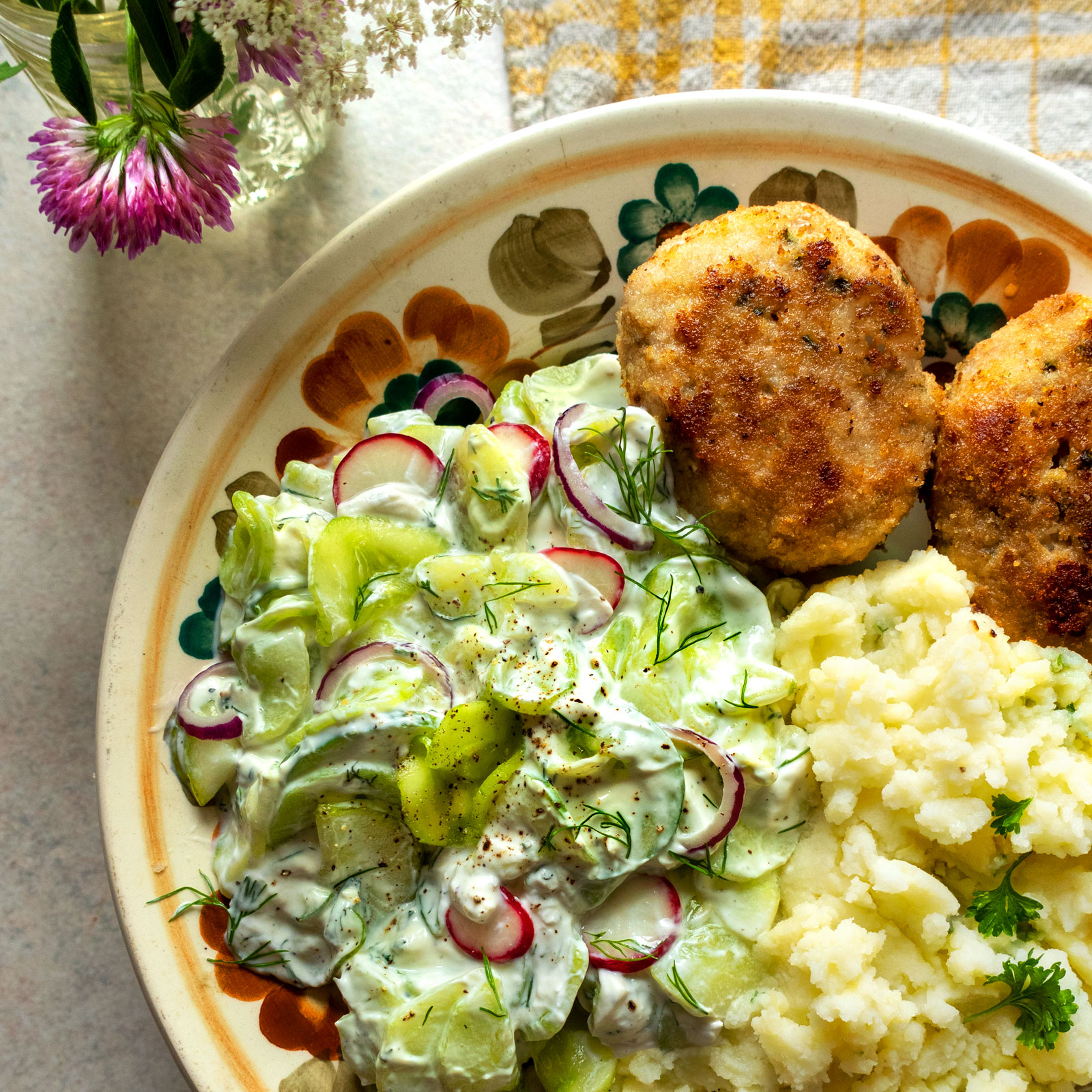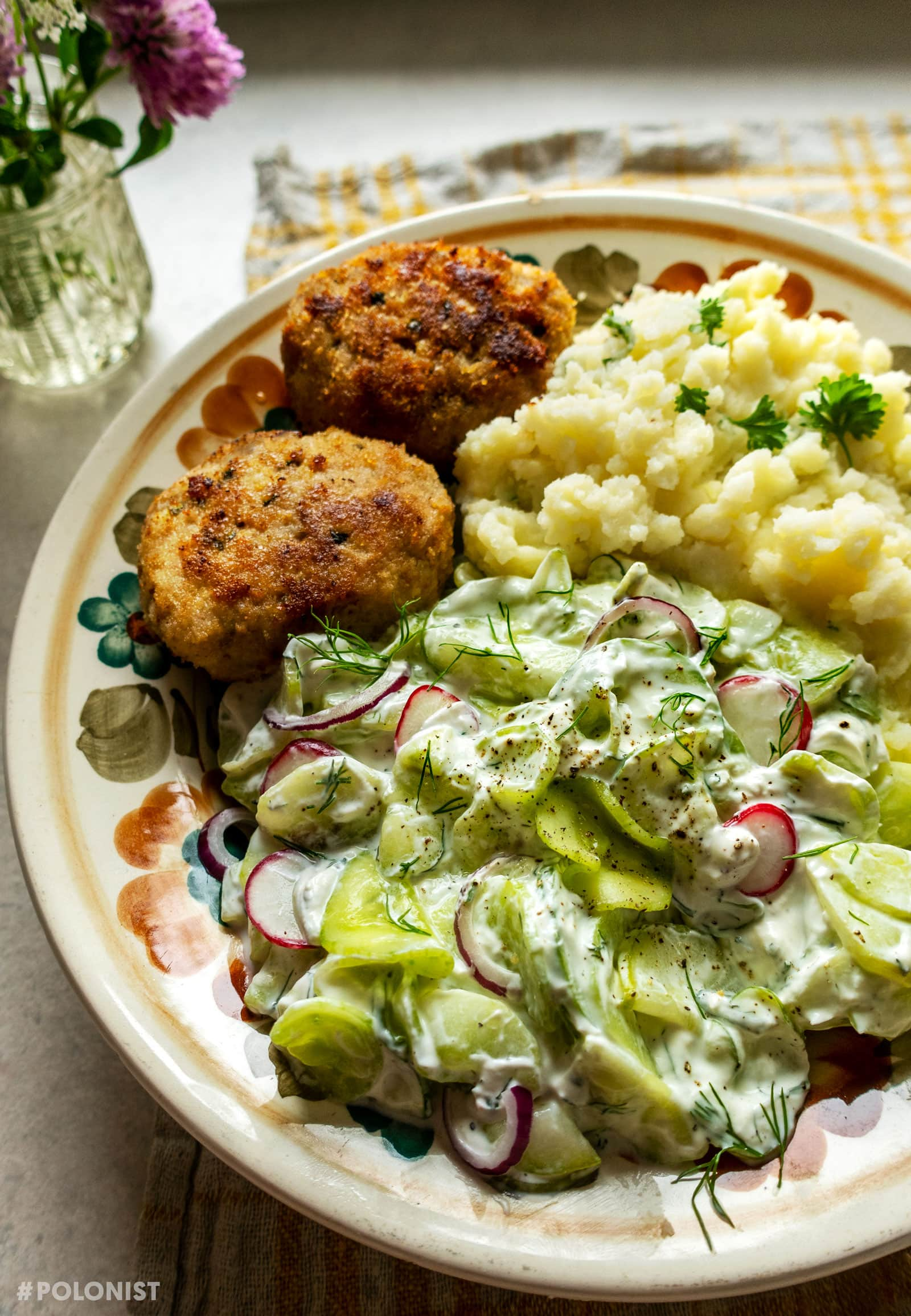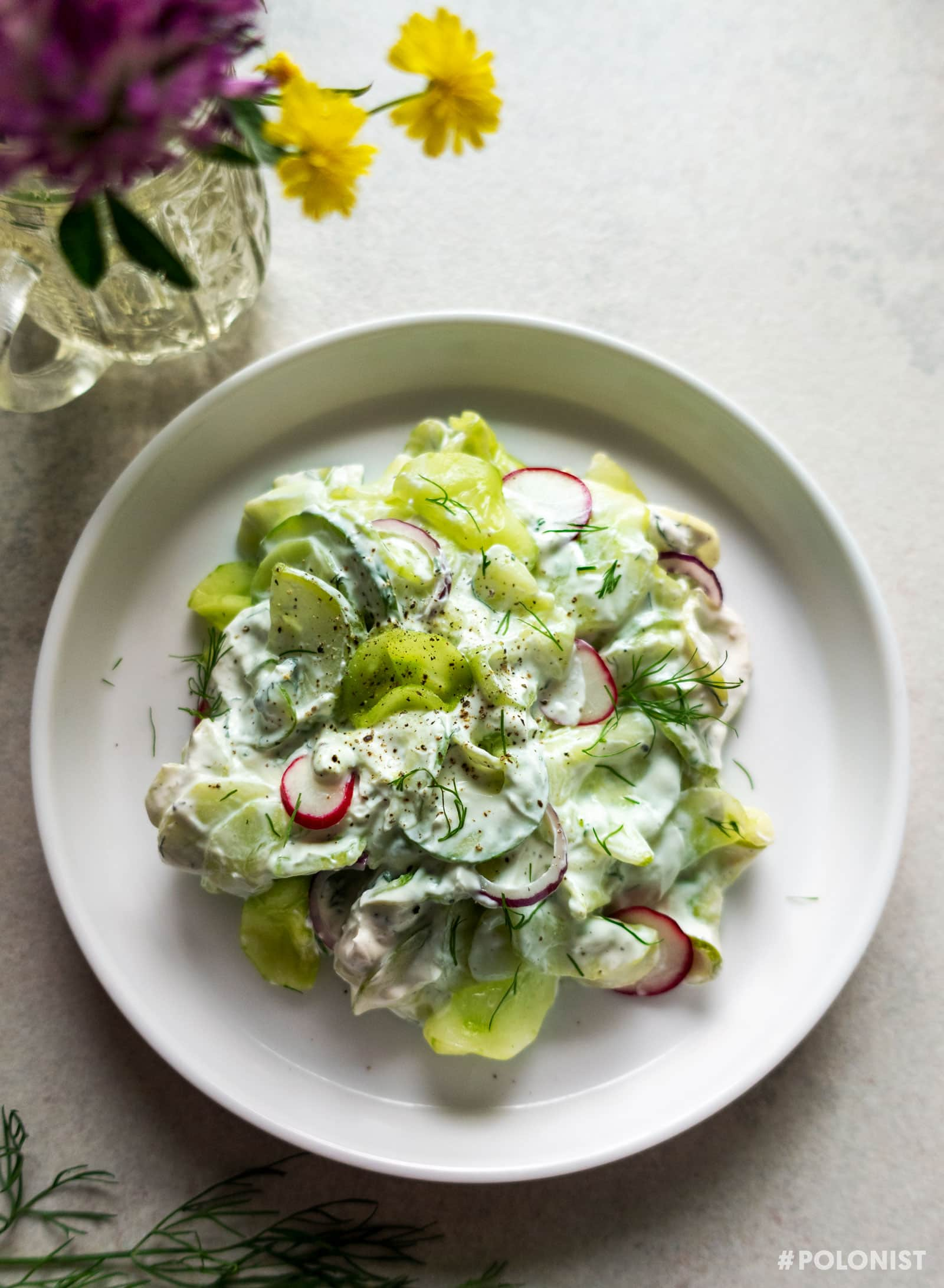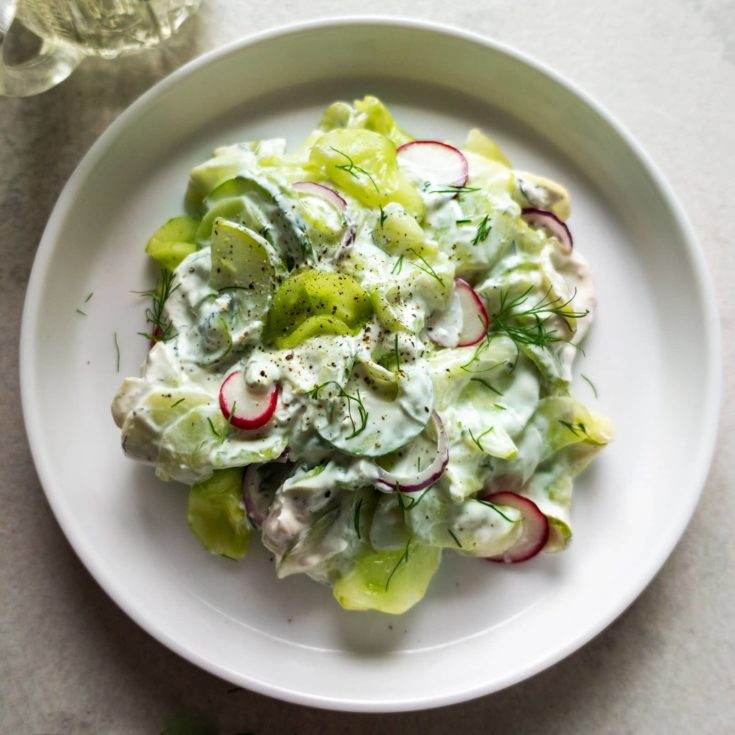Mizeria z Zielonych Ogórków
Mizeria: Polish Cucumber Salad
How to pronounce it?
me-zerya
‘Play’ to hear:

Mizeria is a refreshing Polish-style cucumber salad, made with thinly sliced cukes and rich sour cream. On occasion, another type of dairy is used – such as soured milk, kefir, yoghurt, or buttermilk. In this recipe, we’re using part sour cream and part yogurt, to make our Mizeria a bit lighter.
Other popular additions include herbs (dill, parsley, chives, mint), onions, black pepper, as well as lemon juice or vinegar (apple cider or white wine vinegar).
The most common issue with most Mizeria recipes is that the dressing is way too thin. It dribbles off the cucumbers and runs into everything else on the plate. Luckily, after a few tests and attempts, I’ve found an easy solution to this problem.
Following the method below, the dressing will be rich, insanely creamy and it will really cling to the cukes. Just be sure to start preparing Mizeria the day before you plan to serve.
For the full list of ingredients & detailed instructions, please see the recipe card at the end of this post. But before you scroll, there’s important stuff to know below.
In Latin, ‘Miseria’ translates to misfortune, poverty, and misery. Hardly a suitable name for a salad…
The authors of the “Old Polish traditions in the kitchen and at the table” (source 1), had their own theory regarding the origins of the term:
In their view, Mizeria was a cheap meal of poverty-stricken peasants. It was eaten in the summer when the cucumbers were ripe, but the autumn fruits had not yet appeared.

I’ve read somewhere that in the olden days, a cucumber salad was made with milk instead of cream. That way it was cheaper and even more, well – poor. In fact, it was closer to a cucumber ‘chłodnik’ soup than a salad that we know today.
Despite its humble origins, Mizeria is a delicious side dish, definitely worthy of a place at our dinner table.
Do you need any special ingredients or equipment to make this Mizeria?
No, all of the ingredients should be available in any well-stocked grocery store.
For a large bowl of Mizeria, you’ll need four large cucumbers. English cucumbers are best here – they’re longer, darker, and skinnier than the typical garden cucumbers.
At some stores, you’ll find them pre-wrapped in plastic and labelled as “hothouse”, “seedless” or “burpless”.
In terms of equipment, you’ll need:
- A large bowl and a medium bowl
- colander/large sieve
- Fine-mesh sieve (large enough to hold 24 ounces, 700 ml)
What should you serve with this Polish Cucumber Salad?
Mizeria goes well with nearly any main course. It can accompany any meat dish of your choice – grilled meats, cutlets, roulades, meatballs… serve them alongside a portion of potatoes (boiled, baked, puréed…).

This cucumber salad will also pair well with fried eggs, together with a glass of cold Soured Milk.
Can you make this Mizeria another way?
Yes, there’s a much quicker way to make Mizeria – but let me explain why it’s worth following this longer method instead:
The problem with most Polish-style Cucumber Salad recipes is that the dressing is too watery and thin. It runs right off the cucumbers and into everything else on the plate (not cool!).
The dressing should really cling to the cukes – and all it takes to make that happen is this simple trick:
- salting and straining the cucumbers, and…
- straining the yogurt
Yes, this process takes a few hours. But in return, we get a delicious, impossibly creamy Mizeria.
In addition, in some of the classic recipes I found, sour cream is replaced completely with kefir, buttermilk, or soured milk. The following are also occasionally added: fresh tomatoes, chives, mint, or fresh parsley.
If you’re not a fan of vinegar, feel free to skip it. A touch of lemon juice instead does wonders though, it’s worth adding instead.
What diets is this Creamy Cucumber Salad suitable for?
This recipe is suitable for vegetarians. It’s also gluten-free, low-carb, and keto-friendly (just skip the sugar).
How long can you keep this Mizeria in the fridge?
Once served, don’t keep it out at room temperature for more than 3 hours.
To store any leftovers, cover the bowl with some cling film, or move the salad into a container with a lid. Chill in the refrigerator for up to 2 days.
Can I freeze this Cucumber Salad?
Sadly, no – I don’t recommend freezing this recipe. The cucumbers will lose their texture and turn mushy.

Mizeria: Polish Cucumber Salad with Sour Cream

With one simple trick, you'll make the best Cucumber Salad ever! Just make sure to start preparing it the night before.
Ingredients
- 4-5 large cucumbers (approx. 3 pounds, 1.4 kg); English/hothouse; see notes
- 6-7 radishes, optional
- 1 medium (4 ounces, 110 gram) red onion; optional
- 1 ½ tablespoon salt
- 3 cups (24 ounces, 700 ml) plain whole milk yogurt, unsweetened; see notes
- 2 cups (16 ounces, 470-500 ml) sour cream, 18-20% fat
- 2 tablespoons apple cider vinegar, white wine vinegar, or lemon juice
- 1 teaspoon sugar, optional
- 8 tablespoons (0.3 ounces, 9-10 grams) fresh dill, chopped
- 1 teaspoon black pepper, freshly ground; optional
Instructions
- Wash the cucumbers and radishes under cold running water.
- [Peeling] There’s no need to peel this type of cucumbers, as the skin is edible and very thin. I prefer to peel the cucumbers anyway, only leaving ½ of one cucumber unpeeled (mainly for a visual effect).
- Slice the cucumbers through their length into thin medallions. Repeat with the radishes. Set aside.
- [Optional] Cut the onion in half, peel back the skin. Place the onion halves cut side down, and slice them finely into half-moons.
- Drop sliced vegetables (cucumbers, radishes, onion) into a large bowl. Sprinkle one and a half tablespoons of salt and mix everything with a spoon. The aim is to coat the cucumbers with salt evenly.
- Move the veggies into a colander (or a large sieve). Place a large bowl underneath it - it can be the same bowl we have just used, there’s no need for extra cleaning. Cover with a plastic wrap, so the cukes won’t dry up and chill in the fridge for 4-5 hours; or even overnight. We’re not done here just yet though, follow the next step.
- Line a fine-mesh sieve (large enough to hold 24 ounces or 700 ml) with a cheesecloth (loose-woven gauze) or a piece of paper towel. Place it over a bowl.
- Pour the yogurt in, and cover the whole thing with cling film. Again, refrigerate for 4-5 hours; or overnight. We’re done here, for now. See you in a few hours!
- Retrieve both bowls from the refrigerator. Unwrap them and discard the excess liquid that has collected at the bottom.
- Roll the vegetables in paper towels (or a clean kitchen towel) to dry them up and press out any excess juices.
- In a large bowl, add in the yogurt, sour cream, vinegar, sugar, dill, and black pepper. Whisk the dressing together, then add in all the vegetables.
- Toss well and have a taste. We have salted the cucumbers well before, but some of that salt will be gone at this point. I usually add one more teaspoon of salt, but you might need two.
- Refrigerate for a few hours before serving, so that the flavours can develop and blend together. If you’re impatient, you can serve it immediately.
- Right before serving, you can sprinkle ‘Mizeria’ lightly with salt, ground pepper, and a few dill twigs.
Notes
- Cucumbers weighted in total; weighted before peeling. Peeling is optional.
- Plain whole-milk yogurt can be replaced with greek yogurt (also full-fat) or sour cream.
Nutrition Information:
Yield:
8Serving Size:
1Amount Per Serving: Calories: 134Total Fat: 7gSaturated Fat: 4gTrans Fat: 0gUnsaturated Fat: 2gCholesterol: 22mgSodium: 1636mgCarbohydrates: 16gFiber: 2gSugar: 10gProtein: 5g
Polonist is reader-supported. When you buy through links on our site, we may earn a small affiliate commission. Learn more
Recipe Information
Filed under:
Alternative traditional/regional names:
Also known / Misspelt internationally as:
Polish tzatziki
Tested by:
First published on:
Recipe by / Adapted from:
Story by:
Bibliography / References:
- “W staropolskiej kuchni i przy polskim stole” (“Old Polish traditions in the kitchen and at the table” cookbook by Maria Lemnis and Henryk Vitry (the pen name of Tadeusz Żakiej), published in 1979 by Interpress, EAN 8322317123